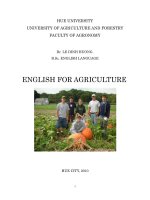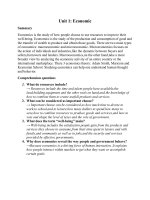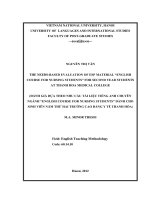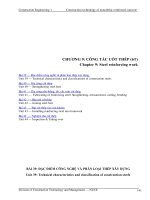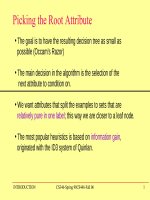Tài liệu tiếng anh chuyên ngành môn máy học
Bạn đang xem bản rút gọn của tài liệu. Xem và tải ngay bản đầy đủ của tài liệu tại đây (193.43 KB, 36 trang )
INTRODUCTION CS346-Spring 98
CS446-Fall 06
1
•
The goal is to have the resulting decision tree as small as
possible (Occam’s Razor)
•
The main decision in the algorithm is the selection of the
next attribute to condition on.
•
We want attributes that split the examples to sets that are
relatively pure in one label; this way we are closer to a leaf node.
•
The most popular heuristics is based on information gain,
originated with the ID3 system of Quinlan.
Picking the Root Attribute
INTRODUCTION CS346-Spring 98
CS446-Fall 06
2
+ - - + + + - - + - + - + +
- - + + + - - + - + - - + - -
+ - + - - + - + - + + - - +
+ - - - + - + - + + - - + +
+ - - + - + - + + - - + - +
- - + + + - + - +
+ - + - + + + - -
+ - + - - + - +
- - + - + - +
- - - + - - -
- + - - + - -
-
+ + + +
+ + + +
- - - - - -
- - - - - -
+ + + + +
+ + + + +
+ + + +
- - + - + - +
- + + +
- - - - - -
- - - - - -
+ + +
+ + +
- - - - -
Highly Disorganized
High Entropy
Much Information Required
Highly Organized
Low Entropy
Little Information Required
INTRODUCTION CS346-Spring 98
CS446-Fall 06
3
•
Expected Information required to know an element’s label
•
Entropy (impurity, disorder) of a set of examples, S, relative
to a binary classification is:
where is the proportion of positive examples in S and
is the proportion of negatives.
•
If all the examples belong to the same category: Entropy = 0
•
If the examples are equally mixed (0.5,0.5) Entropy = 1
)log(pp)log(ppEntropy(S)
−−++
−−=
+
p
−
p
If the probability for + is 0.5, a single bit is required for each example;
If it is 0.8 we need less then 1 bit.
∑
=
−=
k
i
ii
1
)log(pp}), pp,Entropy({p
k21
In general, when p
i
is the fraction of examples labeled i:
Entropy
WHY?
INTRODUCTION CS346-Spring 98
CS446-Fall 06
4
where is the proportion of positive examples in S and
is the proportion of negatives.
•
If all the examples belong to the same category: Entropy = 0
•
If the examples are equally mixed (0.5,0.5) Entropy = 1
+
p
−
p
1
+
1
+
1
+
Entropy
•
Entropy (impurity, disorder) of a set of examples, S, relative
to a binary classification is:
)log(pp)log(ppEntropy(S)
−−++
−−=
INTRODUCTION CS346-Spring 98
CS446-Fall 06
5
where is the proportion of positive examples in S and
is the proportion of negatives.
•
If all the examples belong to the same category: Entropy = 0
•
If the examples are equally mixed (0.5,0.5) Entropy = 1
+
p
−
p
1 1 1
Entropy
)log(pp)log(ppEntropy(S)
−−++
−−=
•
Entropy of a set of examples, S, relative
to a binary classification is:
INTRODUCTION CS346-Spring 98
CS446-Fall 06
6
Information Gain
For Information Gain, Subtract Information required
after split from before
+ - - + + + - - + - + - + +
- - + + + - - + - + - - + - -
+ - + - - + - + - + + - - +
+ - - - + - + - + + - - + +
+ - - + - + - + + - - + - +
- - + + + - + - +
+ - + - + + + - -
+ - + - - + - +
- - + - + - +
- - - + - - -
- + - - + - -
-
+ + + +
+ + + +
Some Expected
Information required
before the split
Some Expected
Information required
after the split
INTRODUCTION CS346-Spring 98
CS446-Fall 06
7
•
The information gain of an attribute a is the expected reduction
in entropy caused by partitioning on this attribute.
where
is the subset of S for which attribute a has value v
and the entropy of partitioning the data is calculated by
weighing the entropy of each partition by its size relative to the
original set
Partitions that lower entropy correspond to high information gain
)Entropy(S
|S|
|S|
Entropy(S)a)Gain(S,
v
v
values(a)v
∑
∈
−=
v
S
Entropy of several sets
Go back to check which of the A, B splits is better
INTRODUCTION CS346-Spring 98
CS446-Fall 06
8
•
Consider data with two Boolean attributes (A,B).
< (A=0,B=0), - >: 50 examples
< (A=0,B=1), - >: 50 examples
< (A=1,B=0), - >: 3 examples
< (A=1,B=1), + >: 100 examples
A
100 +
3 -
100 -
01
•
Splitting on B:
•
What should be the first attribute we select?
•
Splitting on A:
Picking the Root Attribute
B
100 +
50 -
53 -
01
Information gain of A is higher
INTRODUCTION CS346-Spring 98
CS446-Fall 06
9
Generalization
Want assurance of accuracy on fu ture
examples
Computations from the training set are
only estimates
Sequence of decisions build the tree
Local
Dependent
Approximate
How good are the trees?
Interesting question – following our algorithm gives no
guarantee
INTRODUCTION CS346-Spring 98
CS446-Fall 06
10
An Illustrative Example
Day Outlook Temperature Humidity Wind PlayTennis
1 Sunny Hot High Weak No
2 Sunny Hot High Strong No
3 Overcast Hot High Weak Yes
4 Rain Mild High Weak Yes
5 Rain Cool Normal Weak Yes
6 Rain Cool Normal Strong No
7 Overcast Cool Normal Strong Yes
8 Sunny Mild High Weak No
9 Sunny Cool Normal Weak Yes
10 Rain Mild Normal Weak Yes
11 Sunny Mild Normal Strong Yes
12 Overcast Mild High Strong Yes
13 Overcast Hot Normal Weak Yes
14 Rain Mild High Strong No
INTRODUCTION CS346-Spring 98
CS446-Fall 06
11
An Illustrative Example (2)
Day Outlook Temperature Humidity Wind PlayTennis
1 Sunny Hot High Weak No
2 Sunny Hot High Strong No
3 Overcast Hot High Weak Yes
4 Rain Mild High Weak Yes
5 Rain Cool Normal Weak Yes
6 Rain Cool Normal Strong No
7 Overcast Cool Normal Strong Yes
8 Sunny Mild High Weak No
9 Sunny Cool Normal Weak Yes
10 Rain Mild Normal Weak Yes
11 Sunny Mild Normal Strong Yes
12 Overcast Mild High Strong Yes
13 Overcast Hot Normal Weak Yes
14 Rain Mild High Strong No
0.94
)
14
5
log(
14
5
)
14
9
log(
14
9
Entropy(S)
=
−
−
=
9+,5-
Entropy
INTRODUCTION CS346-Spring 98
CS446-Fall 06
12
An Illustrative Example (2)
Humidity Wind PlayTennis
High Weak No
High Strong No
High Weak Yes
High Weak Yes
Normal Weak Yes
Normal Strong No
Normal Strong Yes
High Weak No
Normal Weak Yes
Normal Weak Yes
Normal Strong Yes
High Strong Yes
Normal Weak Yes
High Strong No
9+,5-
E=.94
INTRODUCTION CS346-Spring 98
CS446-Fall 06
13
An Illustrative Example (2)
Humidity Wind PlayTennis
High Weak No
High Strong No
High Weak Yes
High Weak Yes
Normal Weak Yes
Normal Strong No
Normal Strong Yes
High Weak No
Normal Weak Yes
Normal Weak Yes
Normal Strong Yes
High Strong Yes
Normal Weak Yes
High Strong No
9+,5-
Humidity
High
Normal
3+,4-
6+,1-
E=.985
E=.592
E=.94
)Entropy(S
|S|
|S|
Entropy(S)a)Gain(S,
v
v
values(a)v
∑
∈
−=
INTRODUCTION CS346-Spring 98
CS446-Fall 06
14
An Illustrative Example (2)
Humidity Wind PlayTennis
High Weak No
High Strong No
High Weak Yes
High Weak Yes
Normal Weak Yes
Normal Strong No
Normal Strong Yes
High Weak No
Normal Weak Yes
Normal Weak Yes
Normal Strong Yes
High Strong Yes
Normal Weak Yes
High Strong No
9+,5-
Humidity Wind
High
Normal Weak Strong
3+,4-
6+,1- 6+2- 3+,3-
E=.985
E=.592 E=.811 E=1.0
E=.94
)Entropy(S
|S|
|S|
Entropy(S)a)Gain(S,
v
v
values(a)v
∑
∈
−=
INTRODUCTION CS346-Spring 98
CS446-Fall 06
15
An Illustrative Example (2)
Humidity Wind PlayTennis
High Weak No
High Strong No
High Weak Yes
High Weak Yes
Normal Weak Yes
Normal Strong No
Normal Strong Yes
High Weak No
Normal Weak Yes
Normal Weak Yes
Normal Strong Yes
High Strong Yes
Normal Weak Yes
High Strong No
9+,5-
Humidity Wind
High
Normal Weak Strong
3+,4-
6+,1- 6+2- 3+,3-
E=.985
E=.592 E=.811 E=1.0
E=.94
Gain(S,Humidity)=
.94 - 7/14 0.985
- 7/14 0.592=
0.151
)Entropy(S
|S|
|S|
Entropy(S)a)Gain(S,
v
v
values(a)v
∑
∈
−=
INTRODUCTION CS346-Spring 98
CS446-Fall 06
16
An Illustrative Example (2)
Humidity Wind PlayTennis
High Weak No
High Strong No
High Weak Yes
High Weak Yes
Normal Weak Yes
Normal Strong No
Normal Strong Yes
High Weak No
Normal Weak Yes
Normal Weak Yes
Normal Strong Yes
High Strong Yes
Normal Weak Yes
High Strong No
9+,5-
Humidity Wind
High
Normal Weak Strong
3+,4-
6+,1- 6+2- 3+,3-
E=.985
E=.592 E=.811 E=1.0
E=.94
Gain(S,Humidity)=
.94 - 7/14 0.985
- 7/14 0.592=
0.151
Gain(S,Wind)=
.94 - 8/14 0.811
- 6/14 1.0 =
0.048
)Entropy(S
|S|
|S|
Entropy(S)a)Gain(S,
v
v
values(a)v
∑
∈
−=
INTRODUCTION CS346-Spring 98
CS446-Fall 06
17
An Illustrative Example (3)
Outlook
Overcast Rain
3,7,12,13
4,5,6,10,14
3+,2-
Sunny
1,2,8,9,11
4+,0-2+,3-
0.0
0.970 0.970
Day Outlook PlayTennis
1 Sunny No
2 Sunny No
3 Overcast Yes
4 Rain Yes
5 Rain Yes
6 Rain No
7 Overcast Yes
8 Sunny No
9 Sunny Yes
10 Rain Yes
11 Sunny Yes
12 Overcast Yes
13 Overcast Yes
14 Rain No
Gain(S,Outlook)=
0.246
INTRODUCTION CS346-Spring 98
CS446-Fall 06
18
An Illustrative Example (3)
Outlook
Gain(S,Wind)=0.048
Gain(S,Humidity)=0.151
Gain(S,Temperature)=0.029
Gain( S,Outlook)=0.246
INTRODUCTION CS346-Spring 98
CS446-Fall 06
19
An Illustrative Example (3)
Outlook
Overcast Rain
3,7,12,13
4,5,6,10,14
3+,2-
Sunny
1,2,8,9,11
4+,0-2+,3-
Yes? ?
Day Outlook PlayTennis
1 Sunny No
2 Sunny No
3 Overcast Yes
4 Rain Yes
5 Rain Yes
6 Rain No
7 Overcast Yes
8 Sunny No
9 Sunny Yes
10 Rain Yes
11 Sunny Yes
12 Overcast Yes
13 Overcast Yes
14 Rain No
Continue until:
•
Every attribute is included in path, or,
•
All examples in the leaf have same label
INTRODUCTION CS346-Spring 98
CS446-Fall 06
20
An Illustrative Example (4)
Outlook
Overcast
Rain
3,7,12,13
4,5,6,10,14
3+,2-
Sunny
1,2,8,9,11
4+,0-2+,3-
Yes? ?
=Humidity),Gain(S
sunny
.97-(3/5) 0-(2/5) 0 = .97
=Temp),Gain(S
sunny
.97- 0-(2/5) 1 = .57
=Wind),Gain(S
sunny
.97-(2/5) 1 - (3/5) .92= .02
Day Outlook Temperature Humidity Wind PlayTennis
1 Sunny Hot High Weak No
2 Sunny Hot High Strong No
8 Sunny Mild High Weak No
9 Sunny Cool Normal Weak Yes
11 Sunny Mild Normal Strong Yes
INTRODUCTION CS346-Spring 98
CS446-Fall 06
21
An Illustrative Example (5)
Outlook
Overcast
Rain
3,7,12,13
4,5,6,10,14
3+,2-
Sunny
1,2,8,9,11
4+,0-2+,3-
Yes? ?
INTRODUCTION CS346-Spring 98
CS446-Fall 06
22
An Illustrative Example (5)
Outlook
Overcast
Rain
3,7,12,13
4,5,6,10,14
3+,2-
Sunny
1,2,8,9,11
4+,0-2+,3-
YesHumidity ?
NormalHigh
No
Yes
INTRODUCTION CS346-Spring 98
CS446-Fall 06
23
An Illustrative Example (6)
Outlook
Overcast
Rain
3,7,12,13
4,5,6,10,14
3+,2-
Sunny
1,2,8,9,11
4+,0-2+,3-
YesHumidity Wind
NormalHigh
No
Yes
WeakStrong
No
Yes
INTRODUCTION CS346-Spring 98
CS446-Fall 06
24
•
Let S be the set of Examples
Label is the target attribute (the prediction)
Attributes is the set of measured attributes
•
Create a Root node for tree
•
If all examples are labeled the same return a single node tree with Label
•
Otherwise Begin
•
A = attribute in Attributes that best classifies S
•
for each possible value v of A
•
Add a new tree branch corresponding to A=v
•
Let Sv be the subset of examples in S with A=v
•
if Sv is empty: add leaf node with the most common value of Label in S
•
Else: below this branch add the subtree
•
ID3(Sv, Attributes - {a}, Label)
End
Return Root
Summary: ID3(Examples, Attributes, Label)
INTRODUCTION CS346-Spring 98
CS446-Fall 06
25
•
Conduct a search of the space of decision trees which
can represent all possible discrete functions. (pros and cons)
•
Goal: to find the best decision tree
•
Finding a minimal decision tree consistent with a set of data
is NP-hard.
•
Performs a greedy heuristic search: hill climbing without
backtracking
•
Makes statistically based decisions using all available data
Hypothesis Space in Decision Tree Induction
